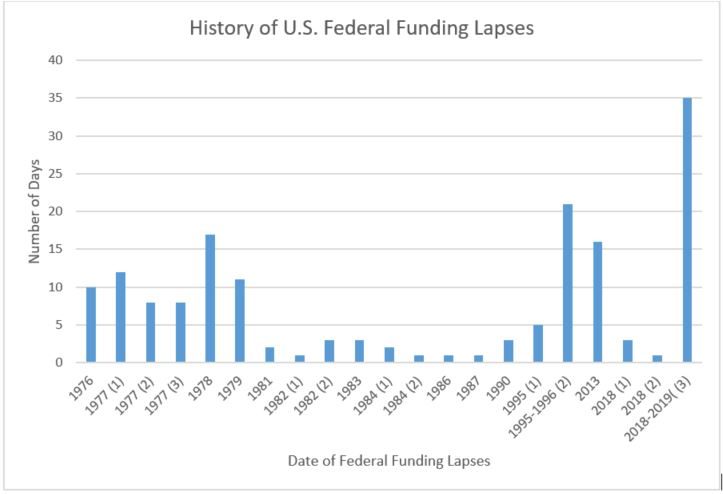
Today’s Morning Buzz is by brand new Morning Buzzer Susan Steward – connect with her on LinkedIn and Twitter!
- What I’m reading: Causal Inference: The Mixtape by Scott Cunningham
- What I’m watching: Kim’s Convenience (the cast is just amazing!)
- What I’m listening to: “High Hopes” Panic! At the Disco
 Strategic planning is probably simultaneously the most over-used and misunderstood term in government today.
Strategic planning is probably simultaneously the most over-used and misunderstood term in government today.
Think about how many local, state, and federal agencies use the term “strategic plan,” or “strategic initiatives”, etc. Does it include fiscal disaster planning?
Disaster planning is often more associated with the idea of natural disasters or extreme circumstances within a centralized locale, but do you have a disaster plan for a lapse in funding? Why is this not part of the strategic plan?
(Fiscal) Planning Isn’t Sexy
Fiscal planning often happens after the moment, and more often than not in response to a specific event. There is seldom a post-mortem to determine what worked well and what could be done differently or how to expand the procedure for other scenarios. Furthermore, there may or may not be a “proactive” plan in place to mitigate the local impact. This is not the case with more understood emergency planning, which is typically tasked to a specific department or group for “emergency management.”
I can only theorize the reasoning fiscal planning isn’t in every government lexicon is largely because fiscal planning isn’t sexy. By sexy I mean, it’s not something that will make headlines or even be often brought down from the shelves or used. Moreover, it’s highly likely that the only type of fiscal emergency considered by many state/local financial actors is what to do in the event of revenue declines as a result of a recession like the Great Recession. Collectively, we as non-federal government actors have become reliant on the “Uncle Sam will get back to work shortly.” We never considered, “what if shortly goes for more than a month, and programs run out of money?”
The Reliance of Uncle Sam
Many programs administered on state and local levels are not just funds from state and local revenues sources, but often do include some form of federal funding. The frequency of the continued lapses in federal funding has become more frequent, and longer.

Source: James V, Saturno, Congressional Research Service, “Federal Funding Gaps: A Brief Overview” and 2018 data from my own notes
Take a moment and jot down each program you think receives federal funding.
Did you include: Supplemental Nutrition Assistance Program (SNAP), Temporary Assistance for Needy Families (TANF), Free and Reduced Meals (FARMs) for schools, Women, Infants, and Children (WIC), Section 8 Housing Assistance, Rental Assistance Vouchers, Build America Bonds, etc.
This could be across more than one governmental department in terms of management and operations, and even partially fund some state/local government employment. The magnitude most likely varies by state, but the importance is still the same. A lapse in federal funding is not centralized, it’s not isolated, and the effects could be long-term if not treated properly. At this point, don’t freak out, but calmly ask, “Do we have a plan or are we reactive? Do we need a plan? If we don’t have one, where do we start?”
What, Who, When, and How?
When completing an emergency plan, all of your financial actors should be in the room.
Last May I attended the 112th Annual Government Finances Officers Association, and one little known presentation discussed being prepared for the next disaster. I was surprised at first because I automatically assumed that there would only be individuals from say executive management, and emergency management offices in attendance. I was shocked that members from finance operations and budgeting were also in attendance. Although this presentation focused more on natural disasters and emergency planning for these cases, the most relevant quote stayed with me when I returned home: “When completing an emergency plan, all of your financial actors should be in the room.”
At the time “emergency fiscal planning” wasn’t necessarily a topic, but many of the guiding principles could still be used to begin the discussions towards building a plan.
- What
- Define your potential disasters/hazards
- Contextualize: Timing/Length, Location, Weather, Other
- Who
- Who and how are they impacted?
- What would be impacted?
- What are your desired outcomes as a result of the plan?
- When
- How long until the lapse occurs/ends?
- What are the fiscal options available?
- What is the time needed from the local perspective to enact the plan to reach the goals?
- How – How will you implement said plan and what resources are needed?
This is a rather large undertaking, and would require buy-in from all agencies impacted. Therefore, it’s not to be taken lightly and in some cases you would need to confirm if you use state funds what is the likelihood of being reimbursed when funding resumes.
For example, the USDA response to local administrators of SNAP in an email from January 18, 2019 warns states against stepping in to cover the cost with no assurance of reimbursement from the federal government.
What Can I Do?
Well, the first step is easy. Ask “do we have a plan?” If not, then propose exploring the ability for a simple internal plan. I have included several resources below, but there are more available online for those interested in building an internal fiscal emergency plan. For us, the simplest way we started was by asking, “What are our cash flows? When do we have money, and when do we need it to pay the bills?” From there, work with internal policy and planning individuals to at least determine what your agency can contribute in the event of a fiscal emergency. Remember, being prepared is often easier than acting in the heat of the moment!
It’s Dangerous to Go Alone, Take These With You
For more information about financial planning in the wake of federal funding lapses I recommend reading:
Congressional Research Service: “Shutdown of the Federal Government: Causes, Processes, and Effects.”
The Environmental Finance Blog: University of North Carolina School of Government Environmental Finance Center: “Local Government Financial Resilience and Preparation Before a Natural Disaster”
Adam Crowe: “Leadership in the Open: A New Paradigm in Emergency Management”
